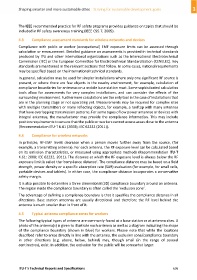Page 619 - Shaping smarter and more sustainable cities - Striving for sustainable development goals
P. 619
The IEEE recommended practice for RF safety programs provides guidance on topics that should be
included in RF safety awareness training (IEEE C95.7, 2005).
4.3 Compliance assessment standards for wireless networks and devices
Compliance with public or worker (occupational) EMF exposure limits can be assessed through
calculation or measurement. Detailed guidance on assessments is provided in technical standards
produced by ITU and other international organizations such as the International Electrotechnical
Commission (IEC) or the European Committee for Electrotechnical Standardization (CENELEC). Key
standards are mentioned in the relevant sections that follow. In some cases, national requirements
may be specified based on the international technical standards.
In general, calculation may be used for simpler installations where only one significant RF source is
present, or where there are few objects in the nearby environment, for example, calculation of
compliance boundaries for antennas on a mobile base station mast. Some sophisticated calculation
tools allow for assessments for very complex installations, and can consider the effects of the
surrounding environment. Furthermore calculations are the only tool in the case of installations that
are in the planning stage or not operating yet. Measurements may be required for complex sites
with multiple transmitters or many reflecting objects, for example, a rooftop with many antennas
that have overlapping transmission patterns. For some types of low power antennas or devices with
integral antennas, the manufacturer may provide the compliance information. This may include
position requirements to ensure that the public or workers cannot access areas close to the antenna
(Recommendation ITU‐T K.61 (2008); IEC 62232 (2011)).
4.4 Compliance for wireless networks
In principle, RF‐EMF levels decrease when a person moves further away from the source, (for
example, a transmitting antenna). For each antenna, the RF exposure level can be calculated based
on its emission characteristics, or measured using appropriate methods (Recommendation ITU‐T
K.61: 2008; IEC 62232, 2011). The distance at which the RF exposure level is always below the RF
exposure limit is called the ‘compliance distance’. The compliance distance may be based on a field
strength, power density or a specific absorption rate (SAR) evaluation (for example, for small cells,
portable devices and tablets). In either case, the compliance distance incorporates a conservative
safety margin.
It is also possible to determine a three dimensional (3D) compliance boundary around an antenna.
The region inside the compliance boundary is often called the ‘exclusion zone’.
The advantage of defining a compliance boundary is that it specifies the compliance distance in all
directions. Base station antennas are usually directional and therefore the RF level behind the
antenna is much smaller than in front of it.
4.5 Typical antenna compliance zones for workers
The following typical types of antenna are commonly found at a base station or at antenna sites. A
photo of the antenna(s) is given to illustrate each antenna as well as a diagram indicating the shape
of the compliance boundary (shown in blue) for workers. Please note that while the locations
described refer to areas directly in line with the antenna, the exclusion zone/compliance boundary
in other directions (e.g. above, below, behind) may, though small (in the range of several
centimetres), exist. In addition, the exclusion for the public will be somewhat larger.
ITU‐T's Technical Reports and Specifications 609

